Despite cool temperatures over most of the Arctic Ocean in January, Arctic sea ice extent continued to track below normal. By the end of January, ice extent dropped below the extent observed in January 2007. Ice extent was unusually low in the Atlantic sector of the Arctic, the one major area of the Arctic where temperatures remained warmer than normal.
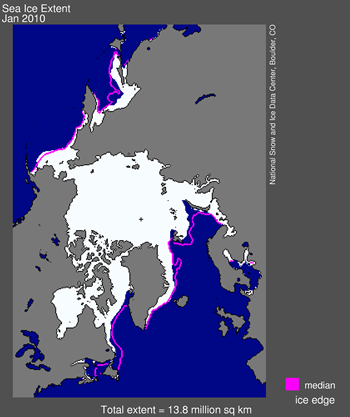 Figure 1. Arctic sea ice extent for January 2010 was 13.78 million square kilometers (5.32 million square miles). The magenta line shows the 1979 to 2000 median extent for that month. The black cross indicates the geographic North Pole. Sea Ice Index data. About the data. —Credit: National Snow and Ice Data Center
Figure 1. Arctic sea ice extent for January 2010 was 13.78 million square kilometers (5.32 million square miles). The magenta line shows the 1979 to 2000 median extent for that month. The black cross indicates the geographic North Pole. Sea Ice Index data. About the data. —Credit: National Snow and Ice Data CenterHigh-resolution image
Overview of conditions
Arctic sea ice extent averaged for January 2010 was 13.78 million square kilometers (5.32 million square miles). This was 1.08 million square kilometers (417,000 square miles) below the 1979 to 2000 average for January, but 180,000 square kilometers (69,000 square miles) above the record low for the month, which occurred in January 2006.
Ice extent remained below normal over much of the Atlantic sector of the Arctic, including the Barents Sea, part of the East Greenland Sea, and in Davis Strait. The only region with above-average ice extent was on the Pacific side of the Bering Sea.
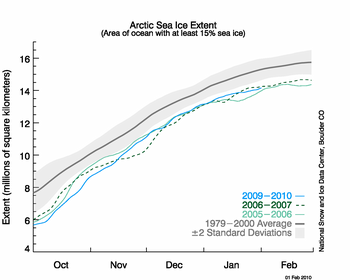 Figure 2. The graph above shows daily sea ice extent as of February 1, 2010. The solid light blue line indicates 2009/2010; dashed green indicates 2006/2007; light green shows 2005/2006 (the record low for the month of January); and solid gray indicates average extent from 1979 to 2000. The gray area around the average line shows the two standard deviation range of the data. Sea Ice Index data.—Credit: National Snow and Ice Data Center
Figure 2. The graph above shows daily sea ice extent as of February 1, 2010. The solid light blue line indicates 2009/2010; dashed green indicates 2006/2007; light green shows 2005/2006 (the record low for the month of January); and solid gray indicates average extent from 1979 to 2000. The gray area around the average line shows the two standard deviation range of the data. Sea Ice Index data.—Credit: National Snow and Ice Data CenterHigh-resolution image
Conditions in context
During January 2010, ice extent grew at an average of 34,000 square kilometers (13,000 square miles) per day. Sea ice extent increased at a fairly steady rate in the early part of the month and then slowed towards the end of January. A brief slowdown in ice growth is not unusual during winter.
Looking over the entire season, this winter continues the recent trend of slower Arctic ice growth. During the 1980s, the average rate of ice growth for January was approximately 90,000 square kilometers (35,000 square miles) per day. In comparison, during the 1990s, the average rate of January growth fell to about 40,000 square kilometers (15,000 square miles) per day. Including 2010, the average for the 2000s is 39,000 square kilometers (15,000 square miles) per day.
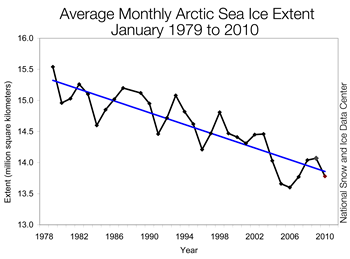
Figure 3. Monthly January ice extent for 1979 to 2010 shows a decline of 3.2% per decade. —Credit: National Snow and Ice Data Center
High-resolution image
January 2010 compared to past years
While Arctic sea ice extent has declined in all seasons, the downward trends in winter ice extent are much smaller than in summer. Polar darkness and low temperatures mean that the ice generally refreezes to about the same boundaries each winter. Ice extent averaged for January 2010 was the fourth lowest for the month since the beginning of satellite records, and 180,000 square kilometers (69,000 square miles) higher than the record low January extent observed in 2006. The linear rate of decline for January is now 3.2% per decade.
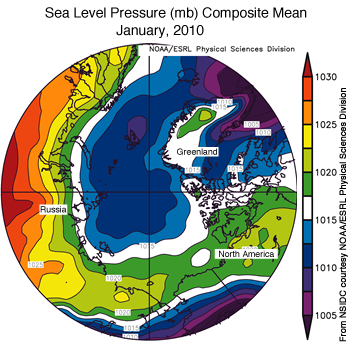
Figure 4. The map of sea level pressure anomalies (in millibars) for January 2010 shows higher than average pressures over western Europe and Asia (areas in orange and red) and lower than average pressures over the central Arctic Ocean (areas in blue and purple. —Credit: National Snow and Ice Data Center courtesy NOAA/ESRL Physical Sciences Division
High-resolution image
A shift in atmospheric circulation
As discussed in our January post, December 2009 was characterized by an extreme negative phase of the Arctic Oscillation, with the Arctic Ocean dominated by unusually high surface pressure and air temperatures. In January, the Arctic Oscillation shifted from strongly negative to neutral in the middle of the month, and then back to a negative phase at the end of the month. For more information on the Arctic Oscillation, see the NOAA Climate Prediction Center Web site.
In contrast to December, January saw unusually low pressure over the central Arctic and unusually high pressure over western Europe and Asia. While temperatures over much of the central Arctic Ocean were 1 to 3 degrees Celsius (2 to 5 degrees Fahrenheit) below normal, temperatures in the Kara and Barents seas were 3 to 5 degrees Celsius (5 to 9 degrees Fahrenheit) warmer than normal. Ice extent was far below normal in the Kara and Barents seas, keeping the total Arctic sea ice extent below average.
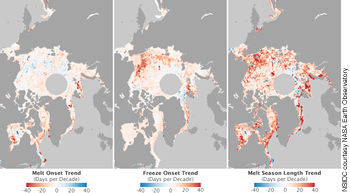
Figure 5. This map of the Arctic shows how earlier melt onset (left) and later freeze onset (middle) have contributed to a longer melt season (right), over the past 30 years.—Credit: NASA Earth Observatory image by Robert Simmon, based on data from Jeffrey Miller and Thorsten Markus, NASA GSFC.
High-resolution image
Slow freeze-up keeps ice extent low
Analysis of data from the last three decades shows that the summer Arctic sea ice melt season now lasts nearly a month longer than it did in the 1980s. A later start of freeze-up and an earlier start to the melt season both contribute to the change. A recent paper by Thorsten Markus at NASA Goddard Space Flight Center suggests that the later freeze-up is the dominant factor lengthening the melt season. The analysis shows that, on average, autumn freeze-up starts nearly four days later each decade. Extensive open water at the end of the summer melt season, combined with warmer autumns, delay the autumn freeze-up. The larger expanses of open water absorb more solar energy, and before ice can form again, that heat must be released back to the atmosphere. This trend is most pronounced in the Beaufort, Chukchi and Laptev seas.
References
Markus, T., J. C. Stroeve, and J. Miller. 2009. Recent changes in Arctic sea ice melt onset, freezeup, and melt season length. Journal of Geophysical Research, 114, C12024, doi:10.1029/2009JC005436.
For previous analyses, please see the drop-down menu under Archives in the right navigation at the top of this page.

